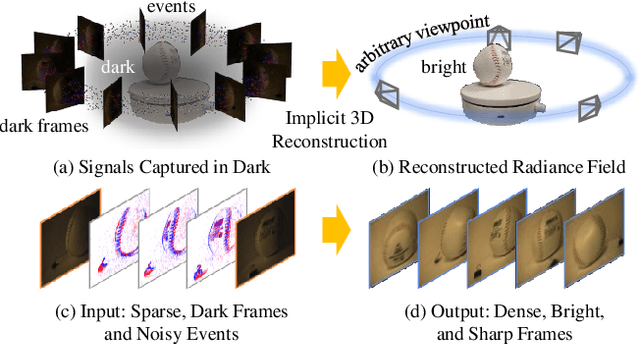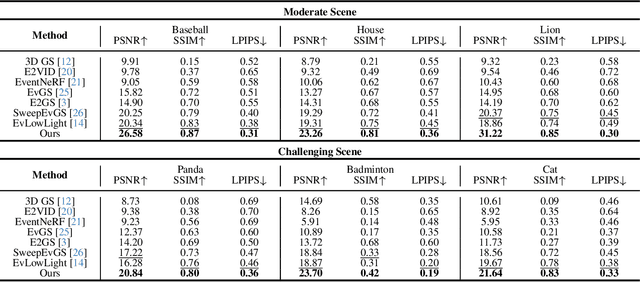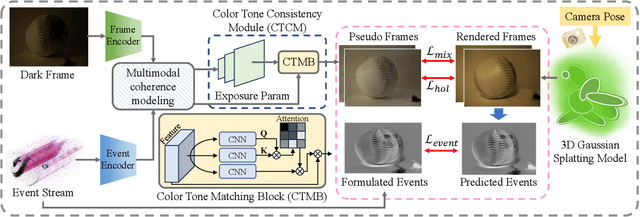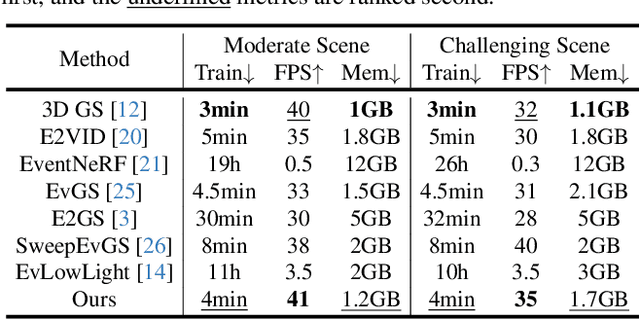Changwei Wang
CurriFlow: Curriculum-Guided Depth Fusion with Optical Flow-Based Temporal Alignment for 3D Semantic Scene Completion
Oct 14, 2025Abstract:Semantic Scene Completion (SSC) aims to infer complete 3D geometry and semantics from monocular images, serving as a crucial capability for camera-based perception in autonomous driving. However, existing SSC methods relying on temporal stacking or depth projection often lack explicit motion reasoning and struggle with occlusions and noisy depth supervision. We propose CurriFlow, a novel semantic occupancy prediction framework that integrates optical flow-based temporal alignment with curriculum-guided depth fusion. CurriFlow employs a multi-level fusion strategy to align segmentation, visual, and depth features across frames using pre-trained optical flow, thereby improving temporal consistency and dynamic object understanding. To enhance geometric robustness, a curriculum learning mechanism progressively transitions from sparse yet accurate LiDAR depth to dense but noisy stereo depth during training, ensuring stable optimization and seamless adaptation to real-world deployment. Furthermore, semantic priors from the Segment Anything Model (SAM) provide category-agnostic supervision, strengthening voxel-level semantic learning and spatial consistency. Experiments on the SemanticKITTI benchmark demonstrate that CurriFlow achieves state-of-the-art performance with a mean IoU of 16.9, validating the effectiveness of our motion-guided and curriculum-aware design for camera-based 3D semantic scene completion.
LargeMvC-Net: Anchor-based Deep Unfolding Network for Large-scale Multi-view Clustering
Jul 28, 2025Abstract:Deep anchor-based multi-view clustering methods enhance the scalability of neural networks by utilizing representative anchors to reduce the computational complexity of large-scale clustering. Despite their scalability advantages, existing approaches often incorporate anchor structures in a heuristic or task-agnostic manner, either through post-hoc graph construction or as auxiliary components for message passing. Such designs overlook the core structural demands of anchor-based clustering, neglecting key optimization principles. To bridge this gap, we revisit the underlying optimization problem of large-scale anchor-based multi-view clustering and unfold its iterative solution into a novel deep network architecture, termed LargeMvC-Net. The proposed model decomposes the anchor-based clustering process into three modules: RepresentModule, NoiseModule, and AnchorModule, corresponding to representation learning, noise suppression, and anchor indicator estimation. Each module is derived by unfolding a step of the original optimization procedure into a dedicated network component, providing structural clarity and optimization traceability. In addition, an unsupervised reconstruction loss aligns each view with the anchor-induced latent space, encouraging consistent clustering structures across views. Extensive experiments on several large-scale multi-view benchmarks show that LargeMvC-Net consistently outperforms state-of-the-art methods in terms of both effectiveness and scalability.
Dark-EvGS: Event Camera as an Eye for Radiance Field in the Dark
Jul 16, 2025



Abstract:In low-light environments, conventional cameras often struggle to capture clear multi-view images of objects due to dynamic range limitations and motion blur caused by long exposure. Event cameras, with their high-dynamic range and high-speed properties, have the potential to mitigate these issues. Additionally, 3D Gaussian Splatting (GS) enables radiance field reconstruction, facilitating bright frame synthesis from multiple viewpoints in low-light conditions. However, naively using an event-assisted 3D GS approach still faced challenges because, in low light, events are noisy, frames lack quality, and the color tone may be inconsistent. To address these issues, we propose Dark-EvGS, the first event-assisted 3D GS framework that enables the reconstruction of bright frames from arbitrary viewpoints along the camera trajectory. Triplet-level supervision is proposed to gain holistic knowledge, granular details, and sharp scene rendering. The color tone matching block is proposed to guarantee the color consistency of the rendered frames. Furthermore, we introduce the first real-captured dataset for the event-guided bright frame synthesis task via 3D GS-based radiance field reconstruction. Experiments demonstrate that our method achieves better results than existing methods, conquering radiance field reconstruction under challenging low-light conditions. The code and sample data are included in the supplementary material.
3D-MoRe: Unified Modal-Contextual Reasoning for Embodied Question Answering
Jul 16, 2025



Abstract:With the growing need for diverse and scalable data in indoor scene tasks, such as question answering and dense captioning, we propose 3D-MoRe, a novel paradigm designed to generate large-scale 3D-language datasets by leveraging the strengths of foundational models. The framework integrates key components, including multi-modal embedding, cross-modal interaction, and a language model decoder, to process natural language instructions and 3D scene data. This approach facilitates enhanced reasoning and response generation in complex 3D environments. Using the ScanNet 3D scene dataset, along with text annotations from ScanQA and ScanRefer, 3D-MoRe generates 62,000 question-answer (QA) pairs and 73,000 object descriptions across 1,513 scenes. We also employ various data augmentation techniques and implement semantic filtering to ensure high-quality data. Experiments on ScanQA demonstrate that 3D-MoRe significantly outperforms state-of-the-art baselines, with the CIDEr score improving by 2.15\%. Similarly, on ScanRefer, our approach achieves a notable increase in CIDEr@0.5 by 1.84\%, highlighting its effectiveness in both tasks. Our code and generated datasets will be publicly released to benefit the community, and both can be accessed on the https://3D-MoRe.github.io.
Graph of Verification: Structured Verification of LLM Reasoning with Directed Acyclic Graphs
Jun 14, 2025



Abstract:Verifying the reliability of complex, multi-step reasoning in Large Language Models (LLMs) remains a fundamental challenge, as existing methods often lack both faithfulness and precision. To address this issue, we propose the Graph of Verification (GoV) framework. GoV offers three key contributions: First, it explicitly models the underlying deductive process as a directed acyclic graph (DAG), whether this structure is implicit or explicitly constructed. Second, it enforces a topological order over the DAG to guide stepwise verification. Third, GoV introduces the notion of customizable node blocks, which flexibly define the verification granularity, from atomic propositions to full paragraphs, while ensuring that all requisite premises derived from the graph are provided as contextual input for each verification unit. We evaluate GoV on the Number Triangle Summation task and the ProcessBench benchmark with varying levels of reasoning complexity. Experimental results show that GoV substantially improves verification accuracy, faithfulness, and error localization when compared to conventional end-to-end verification approaches. Our code and data are available at https://github.com/Frevor/Graph-of-Verification.
SAMamba: Adaptive State Space Modeling with Hierarchical Vision for Infrared Small Target Detection
May 29, 2025Abstract:Infrared small target detection (ISTD) is vital for long-range surveillance in military, maritime, and early warning applications. ISTD is challenged by targets occupying less than 0.15% of the image and low distinguishability from complex backgrounds. Existing deep learning methods often suffer from information loss during downsampling and inefficient global context modeling. This paper presents SAMamba, a novel framework integrating SAM2's hierarchical feature learning with Mamba's selective sequence modeling. Key innovations include: (1) A Feature Selection Adapter (FS-Adapter) for efficient natural-to-infrared domain adaptation via dual-stage selection (token-level with a learnable task embedding and channel-wise adaptive transformations); (2) A Cross-Channel State-Space Interaction (CSI) module for efficient global context modeling with linear complexity using selective state space modeling; and (3) A Detail-Preserving Contextual Fusion (DPCF) module that adaptively combines multi-scale features with a gating mechanism to balance high-resolution and low-resolution feature contributions. SAMamba addresses core ISTD challenges by bridging the domain gap, maintaining fine-grained details, and efficiently modeling long-range dependencies. Experiments on NUAA-SIRST, IRSTD-1k, and NUDT-SIRST datasets show SAMamba significantly outperforms state-of-the-art methods, especially in challenging scenarios with heterogeneous backgrounds and varying target scales. Code: https://github.com/zhengshuchen/SAMamba.
Enhancing Text-to-Image Diffusion Transformer via Split-Text Conditioning
May 25, 2025Abstract:Current text-to-image diffusion generation typically employs complete-text conditioning. Due to the intricate syntax, diffusion transformers (DiTs) inherently suffer from a comprehension defect of complete-text captions. One-fly complete-text input either overlooks critical semantic details or causes semantic confusion by simultaneously modeling diverse semantic primitive types. To mitigate this defect of DiTs, we propose a novel split-text conditioning framework named DiT-ST. This framework converts a complete-text caption into a split-text caption, a collection of simplified sentences, to explicitly express various semantic primitives and their interconnections. The split-text caption is then injected into different denoising stages of DiT-ST in a hierarchical and incremental manner. Specifically, DiT-ST leverages Large Language Models to parse captions, extracting diverse primitives and hierarchically sorting out and constructing these primitives into a split-text input. Moreover, we partition the diffusion denoising process according to its differential sensitivities to diverse semantic primitive types and determine the appropriate timesteps to incrementally inject tokens of diverse semantic primitive types into input tokens via cross-attention. In this way, DiT-ST enhances the representation learning of specific semantic primitive types across different stages. Extensive experiments validate the effectiveness of our proposed DiT-ST in mitigating the complete-text comprehension defect.
FDBPL: Faster Distillation-Based Prompt Learning for Region-Aware Vision-Language Models Adaptation
May 23, 2025



Abstract:Prompt learning as a parameter-efficient method that has been widely adopted to adapt Vision-Language Models (VLMs) to downstream tasks. While hard-prompt design requires domain expertise and iterative optimization, soft-prompt methods rely heavily on task-specific hard labels, limiting their generalization to unseen categories. Recent popular distillation-based prompt learning methods improve generalization by exploiting larger teacher VLMs and unsupervised knowledge transfer, yet their repetitive teacher model online inference sacrifices the inherent training efficiency advantage of prompt learning. In this paper, we propose {{\large {\textbf{F}}}}aster {{\large {\textbf{D}}}}istillation-{{\large {\textbf{B}}}}ased {{\large {\textbf{P}}}}rompt {{\large {\textbf{L}}}}earning (\textbf{FDBPL}), which addresses these issues by sharing soft supervision contexts across multiple training stages and implementing accelerated I/O. Furthermore, FDBPL introduces a region-aware prompt learning paradigm with dual positive-negative prompt spaces to fully exploit randomly cropped regions that containing multi-level information. We propose a positive-negative space mutual learning mechanism based on similarity-difference learning, enabling student CLIP models to recognize correct semantics while learning to reject weakly related concepts, thereby improving zero-shot performance. Unlike existing distillation-based prompt learning methods that sacrifice parameter efficiency for generalization, FDBPL maintains dual advantages of parameter efficiency and strong downstream generalization. Comprehensive evaluations across 11 datasets demonstrate superior performance in base-to-new generalization, cross-dataset transfer, and robustness tests, achieving $2.2\times$ faster training speed.
Image Recognition with Online Lightweight Vision Transformer: A Survey
May 06, 2025Abstract:The Transformer architecture has achieved significant success in natural language processing, motivating its adaptation to computer vision tasks. Unlike convolutional neural networks, vision transformers inherently capture long-range dependencies and enable parallel processing, yet lack inductive biases and efficiency benefits, facing significant computational and memory challenges that limit its real-world applicability. This paper surveys various online strategies for generating lightweight vision transformers for image recognition, focusing on three key areas: Efficient Component Design, Dynamic Network, and Knowledge Distillation. We evaluate the relevant exploration for each topic on the ImageNet-1K benchmark, analyzing trade-offs among precision, parameters, throughput, and more to highlight their respective advantages, disadvantages, and flexibility. Finally, we propose future research directions and potential challenges in the lightweighting of vision transformers with the aim of inspiring further exploration and providing practical guidance for the community. Project Page: https://github.com/ajxklo/Lightweight-VIT
CAE-DFKD: Bridging the Transferability Gap in Data-Free Knowledge Distillation
Apr 30, 2025



Abstract:Data-Free Knowledge Distillation (DFKD) enables the knowledge transfer from the given pre-trained teacher network to the target student model without access to the real training data. Existing DFKD methods focus primarily on improving image recognition performance on associated datasets, often neglecting the crucial aspect of the transferability of learned representations. In this paper, we propose Category-Aware Embedding Data-Free Knowledge Distillation (CAE-DFKD), which addresses at the embedding level the limitations of previous rely on image-level methods to improve model generalization but fail when directly applied to DFKD. The superiority and flexibility of CAE-DFKD are extensively evaluated, including: \textit{\textbf{i.)}} Significant efficiency advantages resulting from altering the generator training paradigm; \textit{\textbf{ii.)}} Competitive performance with existing DFKD state-of-the-art methods on image recognition tasks; \textit{\textbf{iii.)}} Remarkable transferability of data-free learned representations demonstrated in downstream tasks.
 Add to Chrome
Add to Chrome Add to Firefox
Add to Firefox Add to Edge
Add to Edge